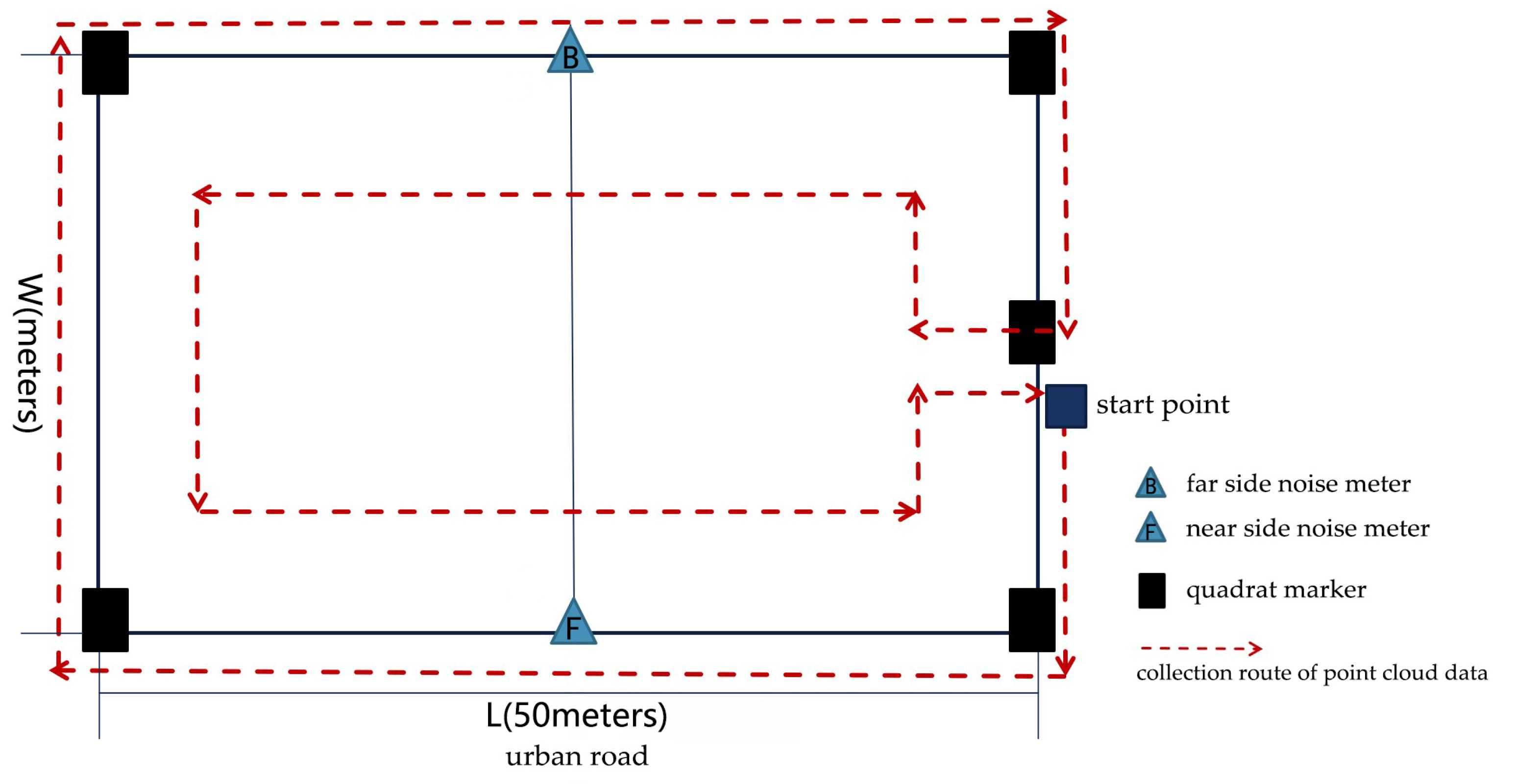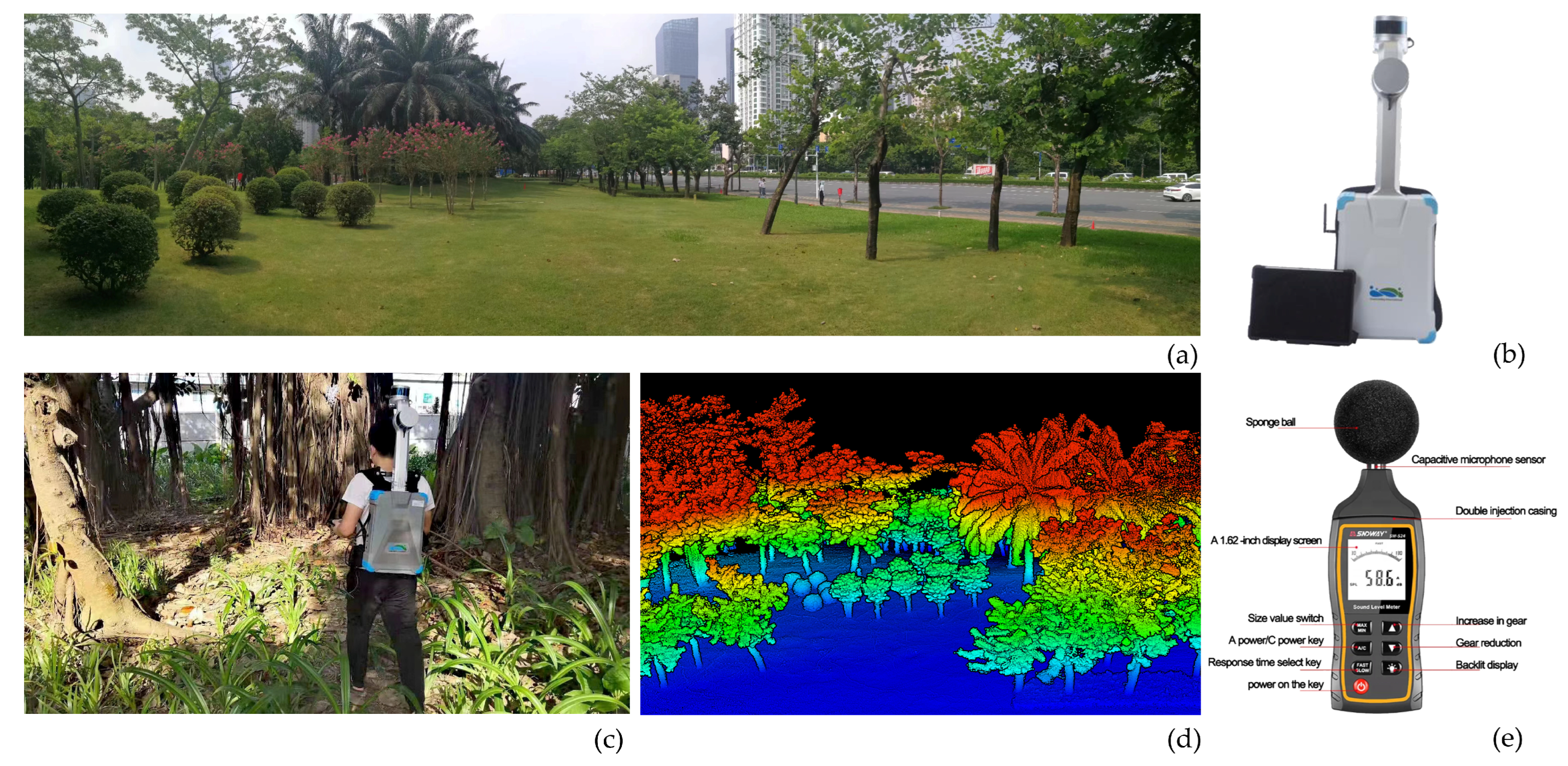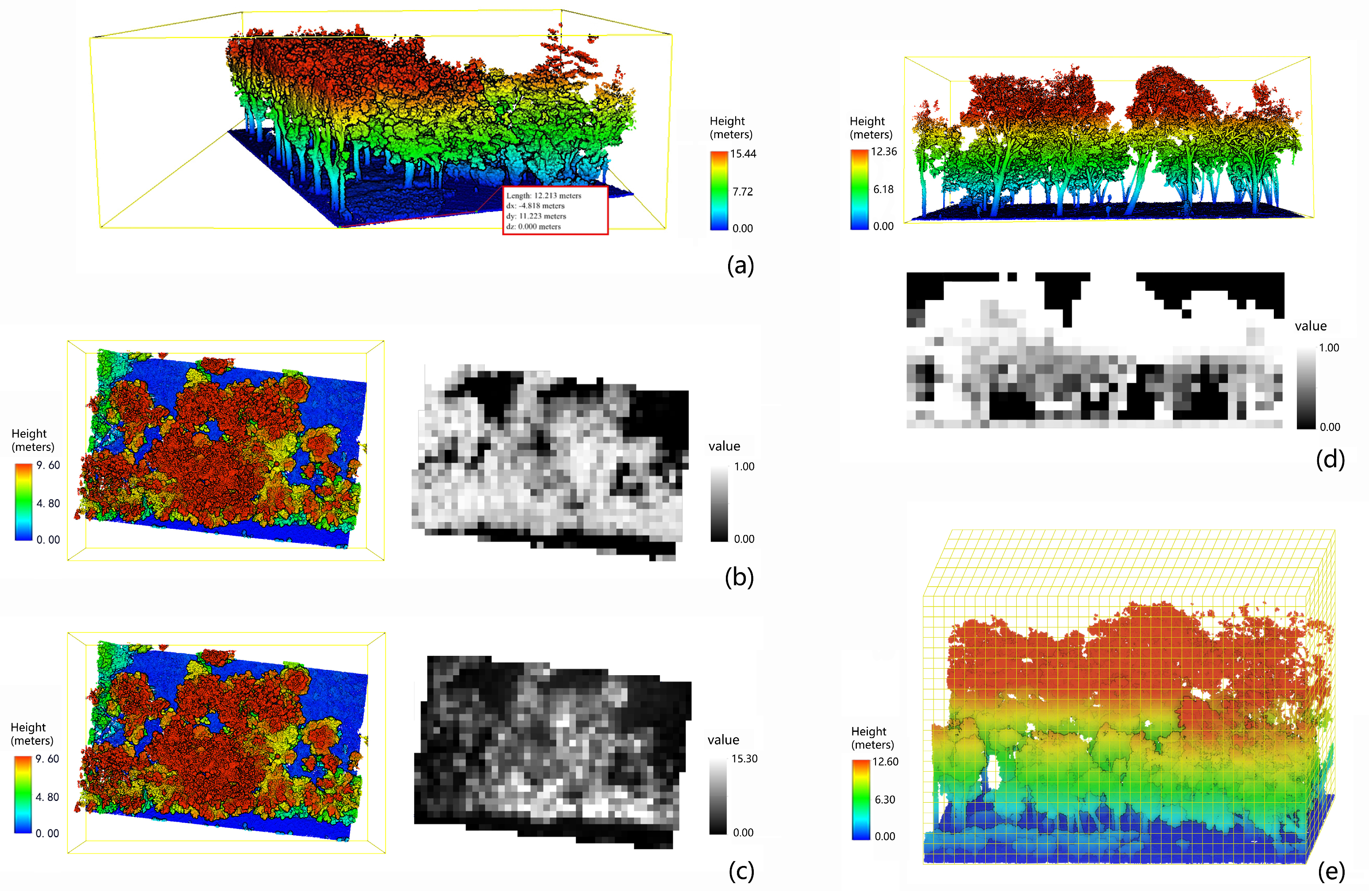Assessing the Traffic Noise Reduction Effect of Roadside Green Space Using LiDAR Point Cloud Data in Shenzhen, China
Abstract
:1. Introduction
2. Materials and Methods
2.1. Study Area
2.2. Quadrat Measurement
2.3. Point Cloud Data Processing
2.4. Noise Data Processing
2.5. Index Selection and Extraction
2.6. Statistical Analysis
3. Results
3.1. Effects of the Vegetation Characteristics at Different Heights on Noise Reduction
3.2. Effects of the Quadrats with Different Lengths on Noise Reduction
3.3. Effects of the Vegetation at Different Locations on Noise Reduction
3.4. Regression Analysis
4. Discussion
5. Conclusions
Author Contributions
Funding
Institutional Review Board Statement
Informed Consent Statement
Data Availability Statement
Conflicts of Interest
References
- Cao, W.; Chen, D.; Shi, Y.; Cao, Z.; Xia, S. Progress and Prospect of Lidar Point Clouds to 3d Tree Models. Geomat. Inf. Sci. Wuhan Univ. 2021, 46, 203–220. [Google Scholar]
- Guo, Q.; Hu, T.; Ma, Q.; Xu, K.; Yang, Q.; Sun, Q.; Li, Y.; Su, Y. Advances for the New Remote Sensing Technology in Ecosystem Ecology Research. J. Plant Ecol. 2020, 44, 418–435. [Google Scholar] [CrossRef]
- Guo, Q.; Liu, J.; Tao, S.; Xue, B.; Le, L.; Xu, G.; Li, W.; Wu, F.; Li, Y.; Chen, L.; et al. Perspectives and Prospects of Lidar in Forest Ecosystem Monitoring and Modeling. Chin. Sci. Bull. 2014, 59, 459–478. [Google Scholar]
- Guo, Q.; Su, Y.; Hu, T.; Guan, H.; Jin, S.; Zhang, J.; Zhao, X.; Xu, K.; Wei, D.; Kelly, M.; et al. Lidar Boosts 3D Ecological Observations and Modelings: A Review and Perspective. IEEE Geosc. Remote Sens. Mag. 2021, 9, 232–257. [Google Scholar] [CrossRef]
- Su, Y.; Guo, Q.; Xue, B.; Hu, T.; Alvarez, O.; Tao, S.; Fang, J. Spatial distribution of forest aboveground biomass in China: Estimation through combination of spaceborne lidar, optical imagery, and forest inventory data. Remote Sens. Environ. 2016, 173, 187–199. [Google Scholar] [CrossRef] [Green Version]
- Sun, X.; Tian, J.; Xu, Y.; Xu, S.; Li, H. Evaluation of Ecological Landscape of Road Based on Terrestrial Laser Scanning: A Case Study of Huanghai National Forest Park. J. Ecol. Rural Environ. 2020, 36, 1477–1484. [Google Scholar]
- Jia, J.; Li, G.; Qiang, X. Research and Application of Automatic Extraction of Landscaping Data Based on Vehicle Point Cloud. Mod Sur. Map. 2019, 42, 49–51. [Google Scholar]
- Cheng, S.; Zhang, G.; Zhang, X.; Liu, Y. Research on the quantitative analysis method of “Green Viewing Ratio” of landscape spatial form based on three-dimensional LiDAR point cloud data. Chin. Landsc. Arch. 2022, 38, 12–19. [Google Scholar]
- Wang, R.; Peethambaran, J.; Chen, D. LiDAR Point Clouds to 3-D Urban Models: A Review. IEEE J. Sel. Top. Appl. Earth Obs. Remote Sens. 2018, 11, 606–627. [Google Scholar] [CrossRef]
- Urech, P.R.W.; Dissegna, M.A.; Girot, C.; Gret-Regamey, A. Point cloud modeling as a bridge between landscape design and planning. Landsc. Urban Plan. 2020, 203, 103903. [Google Scholar] [CrossRef]
- Wang, W.; Guo, X.; Wang, M.; Zhang, P. Research Progress of Traffic Noise Attenuation By Green Belts. J. Nor Agric. For. Univ. 2013, 28, 240–244. [Google Scholar]
- Chen, L.; Xie, G.; Gai, L.; Pei, S.; Zhang, C.; Zhang, B.; Xiao, Y. Research on Noise Reduction Service of Road Green Spacesa Case Study of Beijing. J. Nat. Resour. 2011, 26, 1526–1534. [Google Scholar]
- Han, B.; Shu, C.; Cai, W.; Jia, Q.; Wang, X.; Ouyang, Z. Research Advances in the Impact of Vegetation Community Characteristics on Urban Ecosystem Services. Acta Ecol. Sin. 2021, 41, 9978–9989. [Google Scholar]
- Zhang, J.; Guo, X.; Zhao, C. Nonlinear prediction model of noise reduction by greenbelts. Urban For. Urban Green 2015, 14, 282–285. [Google Scholar] [CrossRef]
- Fang, C.; Ling, D. Guidance for noise reduction provided by tree belts. Landsc. Urban Plan. 2005, 71, 29–34. [Google Scholar] [CrossRef]
- Fang, C.; Ling, D. Investigation of the noise reduction provided by tree belts. Landsc. Urban Plan. 2003, 63, 187–195. [Google Scholar] [CrossRef]
- Samaneh, S.K.; Elham, K.; Hamid, R.N.; Seyed, M.G.; Seyed, M.H.; Mina, A. Investigation of the Traffic Noise Attenuation Provided by Roadside Green Belts. Fluct. Noise Lett. 2015, 14, 1550036. [Google Scholar]
- Wang, H.; Guo, J.; Zhang, Y.; Wei, H.; Feng, L. Study on Noise Attenuation Impact of Roadside Tree-belts and Related Influence Factors. J. Ecol. Environ. Sci. 2010, 19, 1403–1408. [Google Scholar]
- Sun, W.; Wang, W.; Guo, X.; Peng, H. Comparison on Attenuation Effect of Green Belts with Different Types on Traffic Noise. J. Plant Resour. Environ. 2014, 23, 87–93. [Google Scholar]
- Li, G.; Xiong, J.; Xu, M.; Dong, L. Comprehensive Study on the Noise Reduction Ability and the Visual Effect on the Edge of Green Space of Beijing Urban Park. J. Beijing For. Univ. 2017, 39, 93–104. [Google Scholar]
- Zhang, Q.; Zheng, S.; Xia, L.; Wu, H.; Zhang, M.; Li, M. Noise-reduction Function and Its Affecting Factors of Urban Plant Communities in Shanghai. J. Appl. Ecol. 2007, 2295–2300. [Google Scholar]
- Pal, A.K.; Kumar, V.; Saxena, N.C. Noise Attenuation By Green Belts. J. Sound Vib. 2000, 234, 149–165. [Google Scholar] [CrossRef]
- Md, N.I.; Khandkar-Siddikur, R.; Md, M.B.; Md, A.H.; Keisuke, A.; Nobuaki, H. Pollution attenuation by roadside greenbelt in and around urban areas. Urban. For. Urban Green. 2012, 11, 460–464. [Google Scholar]
- Ow, L.F.; Ghosh, S. Urban cities and road traffic noise: Reduction through vegetation. Appl. Acoust. 2017, 120, 15–20. [Google Scholar] [CrossRef]
- Timothy, V.R. Guidelines for optimizing road traffic noise shielding by non-deep tree belts. Ecol. Eng. 2014, 69, 276–286. [Google Scholar]
- Hu, J.; Ge, J. Attenuation Effect of City Green Belt and Simulation on Traffic Noise. Urban Environ. Urban Ecol. 2013, 26, 33–36. [Google Scholar]
- Zhang, H. Study on the Parameter Design of Highway Green Belts Noise Reduction. High Auto Appl. 2009, 156–159. [Google Scholar]
- Zhou, J.; Zhang, L.; Ma, H.; Zhang, W. Comparison and Evaluation of Airborne Lidar Point Cloud Data Processing Software. GeoSpa Inf. Technol. 2019, 42, 101–104. [Google Scholar]
- Zhang, W.; Liu, J.; Hu, H.; Xiao, L.; Li, X. Effect of the Construction of Green Belts on the Attenuation of Traffic Noise Along the Urban Trunk Roads in Xiamen City. Subtrop. Plant Sci. 2009, 38, 74–78. [Google Scholar]
- Ma, Q.; Su, Y.; Guo, Q. Comparison of Canopy Cover Estimations from Airborne LiDAR, Aerial Imagery, and Satellite Imagery. IEEE J. Sel. Top. Appl. Earth Obs. Remote Sens. 2017, 10, 4225–4236. [Google Scholar] [CrossRef]
- Chen, J.M.; Black, T.A. Measuring leaf area index of plant canopies with branch architecture. Agric. For. Meteorol. 1991, 57, 1–12. [Google Scholar] [CrossRef]
- Guo, X.; Peng, H.; Wang, L. The Effects of Traffic Noise Attenuation by Green Belts. Acta Sci. Circumstantiae 2009, 29, 2567–2571. [Google Scholar]







| Previous Studies | This Study | |
|---|---|---|
| Research object | Single tree species or mixed pure forest belt; park plant community | Complex vegetation structure green space |
| Object characteristic | The differences of monomer characteristics are small, and the indices can be easily extracted | The differences of monomer characteristics are large, and it is difficult to extract indices |
| Index selection | Focus on individual indices such as diameter at breast height [22], tree height [15], crown width and height of lower branch of trees [21] | Focus on group indices such as coverage degree, horizontal occlusion degree, percentage of point cloud grid, leaf area index |
| Technical method | Quadrat feature classification; extract individual indices by testing each plant, determination of canopy density by standard diagonal sample point method, use digital image processing method to measure the porosity [18]; extract visibility based on human visual effect [16] or visual shielding rate [26] | All quadrats need not be classified; unified extraction of quadrat vegetation point cloud data; vegetation characteristic indices are selected and constructed on the point cloud data processing and analysis platform; use corresponding algorithms to extract various indices |
| Methodological characteristic | The data are relatively subjective, sensitive to individual indices, and difficult to quantify spatial differences | The data are objective, not sensitive to individual indices, and the differences of spatial distribution can be quantified |
| Application angle | Comparison and analysis of some tree species; evaluation of noise reduction effect of simple structure green space | Evaluation of noise reduction effect of green space with complex vegetation structure features |
| Characteristic Factor/Unit | Connotation | Index Extraction Method |
|---|---|---|
| Width (W)/m | The vertical distance from the front edge of the green space (near road side) to the rear edge of green space (far road side) | Length measurement: measure the distance between the noise meter on the near road side and the noise meter on the far road side |
| Coverage degree (C)/% | Percentage of the quadrat occupied by the vertical projection of tree crowns [30] | Coverage module (1 m resolution, 0.1 m height threshold): Calculate and obtain quadrat coverage raster data, and read the average value |
| Leaf area index (A)/non- dimensional | Leaf area index of vegetation in the quadrat (half the total foliage area per unit ground surface area) [31] | Leaf area index module (1 m resolution, coefficient 1.5, that is, 1.5 times the average point distance of the point cloud): Calculate and obtain the grid data of the leaf area index of the quadrat, and read the average value |
| Horizontal occlusion degree (S)/%/newly constructed index | Occlusion ratio of vegetation on the front of the quadrat (vertical direction from near road side to far road side) | Horizontal occlusion module (1 m resolution): Calculate the grid data of the quadrat occlusion in the horizontal direction (from the near point coordinate to the far point coordinate to determine the direction), and read the average value |
| Percentage of point cloud grid (D)/%/newly constructed index | Percentage of point clouds in the quadrat | Three-dimensional grid point cloud module: take the 0.05 m side length as the unit of three-dimensional grid unit, and count the proportion of the number of grids containing point cloud data in the quadrat to the total number of grids |
| 2 Meters | 5 Meters | 8 Meters | Absolute Height | |
|---|---|---|---|---|
| Width (W) | - | - | - | 0.607 *** |
| Coverage degree (C) | 0.397 *** | 0.448 *** | 0.333 *** | 0.054 |
| Leaf area index (A) | 0.362 *** | 0.496 *** | 0.356 *** | 0.143 |
| Horizontal occlusion degree (S) | 0.648 *** | 0.677 *** | 0.635 *** | - |
| Percentage of point cloud grid (D) | 0.511 *** | 0.585 *** | 0.565 *** | - |
| 30 Meters | 40 Meters | 50 Meters | |
|---|---|---|---|
| Horizontal occlusion degree (S) | 0.625 *** | 0.634 *** | 0.677 *** |
| 50% Quadrat (Nearside) | 50% Quadrat (Farside) | |
|---|---|---|
| Percentage of point cloud grid (D) | 0.475 *** | 0.371 *** |
| Non-Standardized Coefficient | Standardization Coefficient | t | p | VIF | R2 | Adjusted R2 | F | ||
|---|---|---|---|---|---|---|---|---|---|
| B | Beta | ||||||||
| 1 | Constant | −7.670 | - | −4.198 | 0.000 ** | - | 0.645 | 0.630 | F = 41.418, p = 0.000 |
| NF | 0.076 | 0.254 | 3.206 | 0.002 ** | 1.611 | ||||
| W | 0.036 | 0.016 | 2.193 | 0.031 * | 3.005 | ||||
| S | 4.634 | 0.309 | 3.597 | 0.001 ** | 1.891 | ||||
| W × A | 0.006 | 0.255 | 2.319 | 0.023 * | 3.103 | ||||
| 2 | Constant | −6.413 | - | −3.218 | 0.002 ** | - | 0.642 | 0.627 | F = 40.876, p = 0.000 |
| NF | 0.074 | 0.246 | 2.987 | 0.004 ** | 1.728 | ||||
| S | 3.095 | 0.206 | 2.073 | 0.041 * | 2.517 | ||||
| W × S | 0.059 | 0.414 | 4.490 | 0.000 ** | 2.168 | ||||
| A × D | 0.143 | 0.205 | 2.193 | 0.031 * | 2.222 | ||||
Publisher’s Note: MDPI stays neutral with regard to jurisdictional claims in published maps and institutional affiliations. |
© 2022 by the authors. Licensee MDPI, Basel, Switzerland. This article is an open access article distributed under the terms and conditions of the Creative Commons Attribution (CC BY) license (https://creativecommons.org/licenses/by/4.0/).
Share and Cite
Xu, C.; Han, B.; Lu, F.; Wu, T. Assessing the Traffic Noise Reduction Effect of Roadside Green Space Using LiDAR Point Cloud Data in Shenzhen, China. Forests 2022, 13, 765. https://doi.org/10.3390/f13050765
Xu C, Han B, Lu F, Wu T. Assessing the Traffic Noise Reduction Effect of Roadside Green Space Using LiDAR Point Cloud Data in Shenzhen, China. Forests. 2022; 13(5):765. https://doi.org/10.3390/f13050765
Chicago/Turabian StyleXu, Chao, Baolong Han, Fei Lu, and Tong Wu. 2022. "Assessing the Traffic Noise Reduction Effect of Roadside Green Space Using LiDAR Point Cloud Data in Shenzhen, China" Forests 13, no. 5: 765. https://doi.org/10.3390/f13050765
APA StyleXu, C., Han, B., Lu, F., & Wu, T. (2022). Assessing the Traffic Noise Reduction Effect of Roadside Green Space Using LiDAR Point Cloud Data in Shenzhen, China. Forests, 13(5), 765. https://doi.org/10.3390/f13050765





